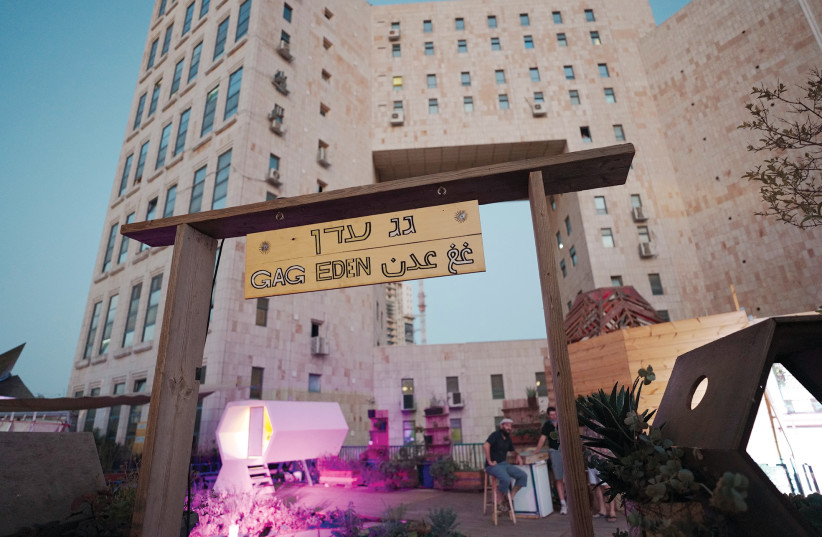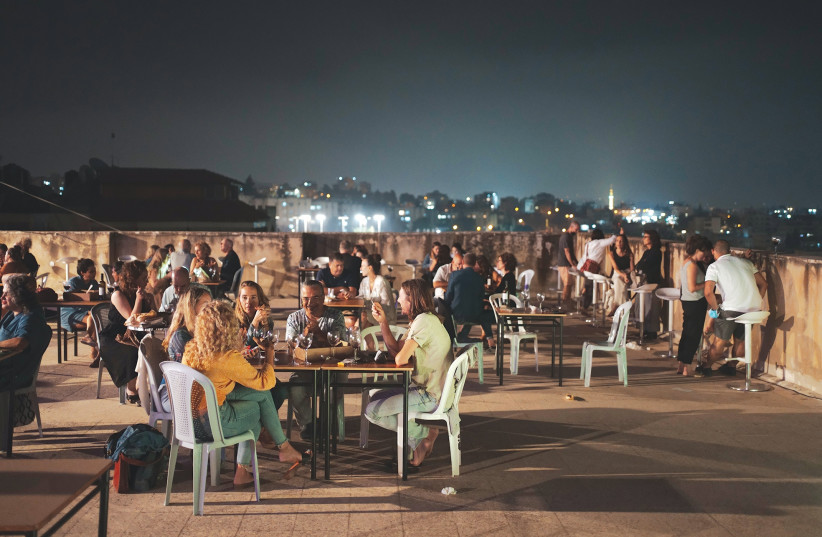The sophomore edition of the event takes in dozens of rooftop tours, a Roof Pioneer Conference, culinary slots, parties, live music and movie screenings.
By BARRY DAVIS
Published: JUNE 5, 2022

As the city skyline continues to spiral heavenward, we are beginning to get used to the idea of looking up – that is if we ever get our head out of our cell phone screen. Construction in Jerusalem is in full swing, and it is a rarity to find an unused plot of land. Thus, if we really are taking on board some of the pressing ecological messages that have been underscored by the events of the past couple of years, we need to do something about adding some greenery to the urban concrete jungle.
That is the basic thinking behind the Gag Eden Festival which runs in Jerusalem, from June 6-9. The sophomore edition of the event – the title is a play on Gan Eden, Garden of Eden, and translates as Roof of Eden – takes in dozens of rooftop tours, a Roof Pioneer Conference, culinary slots, parties, live music and movie screenings.
Green rooftops
The idea of introducing more greenery, more of Mother Nature’s simple wholesome beauty, to the urban jungle – and the seemingly endless procession of concrete and iconic Jerusalem facing stonework – strikes one as being more than a little on the oxymoronic side. Sitting on the Muslala rooftop, in the Clal Building near the shuk, the flower and plant beds evoke powerful emotions and trigger the senses when one views them against a backdrop of the soaring mass of a nearby office tower.
Muslala, and its honcho and cofounder Matan Israeli, are the driving force behind the local event that is part of World Green Roof Day. The global itinerary has towns and cities around the world going increasingly green in an effort to adapt to, and hopefully mediate, climate change. As the umbrella organization website notes, in a veritable nutshell: “Green roofs also provide vital wildlife habitat and make life better for everyone.”
THE INAUGURAL Gaga Eden Festival was a great success. (credit: SNIR KAZIR)
Israeli says all the above activities, and others, are part and parcel of efforts to keep planet Earth on a habitable, even keel, on all sorts of levels. “This year we are connecting with the global network that promotes these things,” he notes. “On June 6, around 70 cities and towns all over the world will celebrate Green Roof Day.”
THE ECOLOGICAL program in the capital is impacting elsewhere in the country. “This year, for the first time, there will be events in Tel Aviv and Haifa, too,” Israeli continues. “We are creating a network that is starting to collect the gray, tough urbanism of stone and cement, and covering all that with a soft layer. We will encounter greenery, vegetation, animals and people. We add another layer of vitality to the city.”
According to Israeli, the latter refers to human nature as well as the stuff that grows out of soil. “People like to move to the country, because it’s pleasant and green. But it’s nice in town, too, because there are roofs and loads of communities that got together to manage the roofs.”
There’s a lot of logic to Israeli’s viewpoint. While there may not be much in the way of ground level space, where we can plant flowers and shrubberies – and, possibly, cultivate edibles, thereby not only providing ourselves with fresh salad ingredients but also making the cityscape easier on the eye – there is an almost infinite supply of roof space. The tops of buildings in this country are almost invariably flat and, thus, lend themselves to all kinds of activities that can do much to improve the quality of our lives.
“We live in a sort of dissonant situation,” Israeli suggests. “People who feel they have made a success of their life live in rustic surroundings, in a tranquil place where their children run around in nature, and have managed to detach themselves from the violent, gray and intense city.”
Sounds idyllic and, perhaps, something to which we should all aspire. Israeli begs to differ. “We feel this reflects a collective dissonance. The city is where most of humankind lives, and if most people’s dream is to live outside the city, that means we have failed. We need to have a new dream which is fundamentally urban.”
The man has a cogent point. We can’t all live in detached houses with a dunam or two of land to grow our veggies and – horror of ecological horrors – cultivate our manicured lawn. It might make for a nice dream but it is totally impractical. We’d run out of space in no time.
ALL WE NEED to do, says Israeli, is look to the skies. Well, not quite that far up. “Here, the green expanses the roofs accommodate, and the infinite potential of roofs that account for 90% of the city roofs – if we relate to that, we can begin to galvanize the new dream: to make the green urban dream a reality. Ninety percent of roofs in the city are unused.”
That certainly is food for thought, and not just on aesthetic grounds. In cities like Barcelona, where environmentally friendly architecture is more prevalent, it has been shown that getting our building tops to sprout also helps to reduce interior climates, by blocking the rays of the sun. That can presumably also help to cut down on the use of air conditioners and, thus, bring down greenhouse gas emissions.
Israeli’s ideas certainly sound like they could have across-the-board benefits but are they practicable? How convoluted would their implementation be? “We are not talking about complex and costly setups here,” he says. “We are talking about very basic technologies – stones, plants, soil and all sorts of bedding. These are very simple things; everything is there. It is just a matter of orders of priority.”
Now the man is getting down to the cold reality of governmental practice. When, for example, some minister or other, or some municipal authority, pleads poverty only to dole out millions, if not billions, in other areas they clearly feel are more important – probably for their own political ends – that begs basic questions.
Most would agree that global warming is a fact of life, and one that appears to be gathering pace. Perhaps the rise in sea levels may not be top of the existential agenda of the average hill dweller, such as Jerusalemites or people in Haifa. But Tel Avivians, and probably 98% of the population of The Netherlands and other coastal residents around the world may – should – take a very different view.
Israeli says that pressing city roofs into ecological and energy-generating service is a winner all around. “Firstly, there are solar roofs. They can cover your electricity costs. Today, the most interesting initiatives are those that combine solar energy with other systems.
There is, for example, a company called Bing Klima which has a system that combines solar panels with hydroponic agriculture.” The company’s web site explains that “coexistence of solar panels and crops involves light sharing so that panels placed above part of the crop generate shade and create a kind of microclimate over the growing area.”
Sounds perfectly reasonable, and eminently practical. “You can grow your lettuces, or whatever you want to, and also generate electricity,” Israeli continues. “You can also store electricity, or simply channel it back to the grid.”
With Muslala’s enthused and driven team, which also includes the likes of social and educational entrepreneur Eyal Bloch, champion of biodynamic beekeeping Yossi Aud, cultural activist Lidia Meltin, and economist and cultural entrepreneur Rami Ozeri – who also founded and runs the Jerusalem Biennale – perhaps Jerusalem will become a global leader in the green roof sector.
Israeli is not so sure. Much, he feels, rests on the powers that be loosening their purse strings. “It depends how much the municipality takes on a role in this. At the moment the civilian sector is leading this venture, and City Hall is a little behind us. There are other cities, like Tel Aviv and Kfar Saba, that are drawing up [ecological] plans. With the Jerusalem Municipality it is a bit more difficult to get things moving.”
That, says Israeli, is not for want of desire. “There is a consensus here. The mayor also supports us. We need to badger the municipality for funding.”
THE FORTHCOMING festival will hopefully, at the very least, point people in the right direction and make the way forward, toward a greener, healthier, more sane urban existence.
The Roof Pioneer Conference, which takes place on the Muslala rooftop on June 7, will focus on connections between rooftops around the city, and between roofs and street levels. The conference will provide a platform and information for town planners, architects, local authority personnel and other interested parties. Its agenda includes lectures, practical workshops and guided roof tours.
One of the festival’s aims is to promote green thinking and to encourage more Jerusalemites to roll up their sleeves and do something about the ecosystems in their vicinity. The awarding of the Successful Roof Prize, for roofs that have been put to environmental use in the last three years, should act as a catalyst for further ecological derring-do. And the Promised Roof Prize offers a pat on the back for inspirational roof plans.
Other program highlights include an event on the roof of the Museum on the Seam, which will hail the work of women beekeepers from east Jerusalem and host a live show with the merry Las Piratas Piratas street brass band gang. There will also be some top quality vittles on offer, with the raw materials provided by the Food Rescuers, who put cast offs from the wholesale fruit and vegetable market to good, income-generating, healthy and tasty use.
THE LAST evening of the festival sees internationally acclaimed multi-instrumentalist Yossi Fine join forces with drummer son Liam on the Muslala roof to provide a groove-filled, funky, ethnically diverse time for all.
Fine says he is delighted to be on board the Gag Eden initiative. He sees all-round benefits and a shot in the arm for any of us who may still be suffering from a pandemic constraint hangover. “We need people to get out and about, and to meet each other. After the past two years it takes time for people to open up again, to each other, and to live music. We need to get onto Jerusalem roofs, get into some of the greenery and get some good vibes.”
The musician has been into green thinking for some time now. He says that, when he returned to Israel after a 10-year sojourn in New York – where, among other high-profile outings, he worked with late rock-pop megastar David Bowie – he tried to get an ambitious ecological project going. “I suggested to [the hip hop-funk band] Hadag Nahash that they put on around 20 shows, and use the proceeds to buy a building and turn it into an environmentally-friendly building. It didn’t happen,” he chuckles.
That might not have panned out, but Fine’s musical trail continues to produce alluring sonic fruits. He is also happy to be doing good musical business with his son, and says it helps to share some genes. “We haven’t been working together for long, but he is a wonderful drummer.” That smacks just a little of the old “Naches fun di Kinder” (pleasure from the kids) sentiment. First, we have the same blood,” Fine laughs. “We have a musical understanding that only family can have.”
Sounds good. ❖
For more information: www.gag-eden.co.il
https://www.jpost.com/environment-and-climate-change/article-708412

